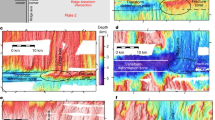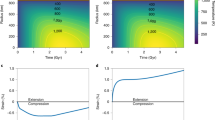Abstract
At mid-ocean spreading centres, extension can be accommodated by slip on large, long-lived (1–2 Myr) detachment faults that expose large tracts of lower crustal gabbroic rocks and mantle peridotite. These structures are known as oceanic core complexes. The development of detachment faults is controlled by the rate at which magma is injected into the brittle lithosphere as intrusive dykes. Recent modelling studies suggested that oceanic core complexes form under low magma injection rates, when only 30–50% of total plate separation is accommodated by the injection of magma into the lithosphere1,2,3. Yet, paradoxically, field observations4,5,6,7,8,9,10,11 document oceanic core complexes that have formed under a spectrum of magma injection rates, from amagmatic to fully magmatic conditions. Here we present a numerical model of oceanic core complex formation that explicitly considers magma intrusion not only in the brittle lithospheric layer, as in earlier simulations1,2,3, but also in the underlying ductile asthenosphere. We find that the rate of magma intrusion into the brittle layer controls fault evolution, whereas the rate of intrusion below the brittle–ductile transition has no influence on fault development, but controls the volume of gabbro exhumed. Our findings suggest that oceanic core complexes can form under high magma intrusion rates if intrusion is accommodated mainly by the ductile asthenosphere, thus reconciling the disparity between prevailing models and field observations.
This is a preview of subscription content, access via your institution
Access options
Subscribe to this journal
Receive 12 print issues and online access
$259.00 per year
only $21.58 per issue
Buy this article
- Purchase on Springer Link
- Instant access to full article PDF
Prices may be subject to local taxes which are calculated during checkout




Similar content being viewed by others
References
Buck, W. R., Lavier, L. L. & Poliakov, A. N. B. Modes of faulting at mid-ocean ridges. Nature 434, 719–723 (2005).
Behn, M. D. & Ito, G. Magmatic and tectonic extension at mid-ocean ridges: 1. Controls on fault characteristics. Geochem. Geophys. Geosyst. 9, Q08010 (2008).
Tucholke, B. E., Behn, M. D., Buck, W. R. & Lin, J. Role of melt supply in oceanic detachment faulting and formation of megamullions. Geology 36, 455–458 (2008).
Tucholke, B. E. & Lin, J. A geological model for the structure of ridge segments in slow spreading ocean crust. J. Geophys. Res. 99, 11937–11958 (1994).
Tucholke, B. E., Lin, J. & Kleinrock, M. C. Megamullions and mullion structure defining oceanic metamorphic core complexes on the Mid-Atlantic Ridge. J. Geophys. Res. 103, 9857–9866 (1998).
Dick, H. J. B. et al. A long in situ section of the lower ocean crust: Results of ODP Leg 176 drilling at the Southwest Indian Ridge. Earth Planet. Sci. Lett. 179, 31–51 (2000).
Blackman, D. K. et al. Geology of the Atlantis Massif (Mid-Atlantic Ridge, 30° N): Implications for the evolution of an ultramafic oceanic core complex. Mar. Geophys. Res. 23, 443–469 (2002).
MacLeod, C. J. et al. Direct geological evidence for oceanic detachment faulting: The Mid-Atlantic Ridge, 15°45′ N. Geology 30, 879–882 (2002).
Dick, H. J. B., Tivey, M. A. & Tucholke, B. E. Plutonic foundation of a slow-spreading ridge segment: Oceanic core complex at Kane Megamullion, 23°30′ N, 45°20′ W. Geochem. Geophys. Geosyst. 9, Q05014 (2008).
MacLeod, C. J. et al. Life cycle of oceanic core complexes. Earth Planet. Sci. Lett. 287, 333–344 (2009).
Xu, M., Canales, J. P., Tucholke, B. E. & DuBois, D. L. Heterogeneous seismic velocity structure of the upper lithosphere at Kane oceanic core complex, Mid-Atlantic Ridge. Geochem. Geophys. Geosyst. 10, Q10001 (2009).
Behn, M. D., Buck, W. R. & Sacks, I. S. Topographic controls on dike injection in volcanic rift zones. Earth Planet. Sci. Lett. 246, 188–196 (2006).
Ito, G. & Behn, M. D. Magmatic and tectonic extension at mid-ocean ridges: 2. Origin of axial morphology. Geochem. Geophys. Geosyst. 9, Q09012 (2008).
Canales, J. P., Tucholke, B. E., Xu, M., Collins, J. A. & DuBois, D. L. Seismic evidence for large-scale compositional heterogeneity of oceanic core complexes. Geochem. Geophys. Geosyst. 9, Q08002 (2008).
Fialko, Y. A. & Rubin, A. M. Thermodynamics of lateral dike propagation: Implications for crustal accretion at slow-spreading ridges. J. Geophys. Res. 103, 2501–2514 (1998).
Cannat, M. How thick is the magmatic crust at slow spreading oceanic ridges? J. Geophys. Res. 101, 2847–2857 (1996).
Escartin, J., Mevel, C., MacLeod, C. J. & McCaig, A. M. Constraints on deformation conditions and the origin of oceanic detachments: The Mid-Atlantic Ridge core complex at 15°45′ N. Geochem. Geophys. Geosyst. 4, 1067 (2003).
Bonatti, E. et al. Mantle thermal pulses below the Mid-Atlantic Ridge and temporal variations in the formation of oceanic lithosphere. Nature 423, 499–505 (2003).
Tucholke, B. E. et al. Segmentation and crustal structure of the western Mid-Atlantic Ridge flank, 25° 25′–27° 10′ N and 0–29 m.y. J. Geophys. Res. 102, 10203–10223 (1997).
Canales, J. P., Collins, J. A., Escartin, J. & Detrick, R. S. Seismic structure across the rift valley of the Mid-Atlantic Ridge at 23° 20′ (MARK area): Implications for crustal accretion processes at slow-spreading ridge. J. Geophys. Res. 105, 28411–28425 (2000).
Cundall, P. A. Numerical experiments on localization in frictional materials. Ingenieur-Archiv. 59, 148–159 (1989).
Poliakov, A. N. B. & Buck, W. R. in In Faulting and Magmatism at Mid-Ocean Ridges (eds Buck, W. R., Karson, J. A. & Lagabrielle, Y.) 305–323 (American Geophysical Union, 1998).
Lavier, L. L. & Buck, W. R. Half-graben versus large-offset low-angle normal fault: Importance of keeping cool during normal faulting. J. Geophys. Res. 107, 2122 (2002).
Mackwell, S. J., Zimmerman, M. E. & Kohlstedt, D. L. High-temperature deformation of dry diabase with application to tectonics on Venus. J. Geophys. Res. 103, 975–984 (1998).
Acknowledgements
Financial support was provided by National Science Foundation Grant (OCE-0548672) to M.D.B., a Mellon Independent Study Award to B.E.T. and by WHOI’s Deep Ocean Exploration Institute. The authors wish to thank J. Escartin, J. Lin, G. Ito and R. Buck for helpful discussions.
Author information
Authors and Affiliations
Contributions
J-A.O. and M.D.B. carried out the modelling and B.E.T. advised on geological interpretations. J-A.O. took the lead in writing the manuscript; M.D.B. and B.E.T. provided comments and revisions.
Corresponding author
Ethics declarations
Competing interests
The authors declare no competing financial interests.
Rights and permissions
About this article
Cite this article
Olive, JA., Behn, M. & Tucholke, B. The structure of oceanic core complexes controlled by the depth distribution of magma emplacement. Nature Geosci 3, 491–495 (2010). https://doi.org/10.1038/ngeo888
Received:
Accepted:
Published:
Issue Date:
DOI: https://doi.org/10.1038/ngeo888
This article is cited by
-
How transform fault shear influences where detachment faults form near mid-ocean ridges
Scientific Reports (2023)
-
Lithological structure of western Pacific lithosphere reconstructed from mantle xenoliths in a petit-spot volcano
Progress in Earth and Planetary Science (2022)
-
Low-degree mantle melting controls the deep seismicity and explosive volcanism of the Gakkel Ridge
Nature Communications (2022)
-
Generation and evolution of the oceanic lithosphere in the North Atlantic
La Rivista del Nuovo Cimento (2022)
-
Large along-axis variations in magma supply and tectonism of the Southeast Indian Ridge near the Australian-Antarctic Discordance
Acta Oceanologica Sinica (2020)



